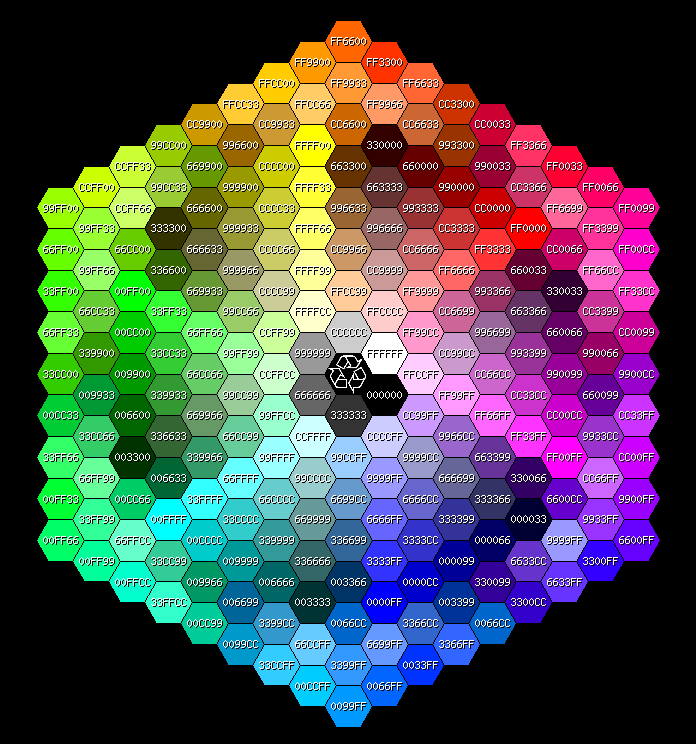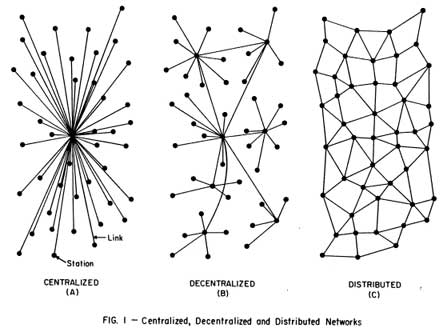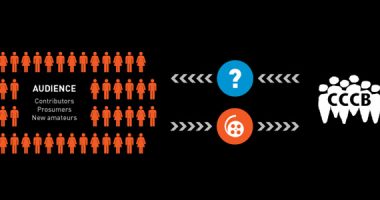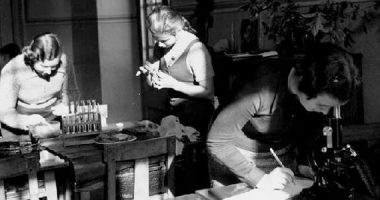The starting point for this paper is an interest in the shared language between socially engaged (relational) practices and new media art, which has led me to develop the Open Source Embroidery (OSE) project. Informed by the free and open source software movement and socially engaged arts practice, Open Source Embroidery has been developed through three key concepts:
- Investigation of (im)materiality, with a focus on the digital as material
- Facilitating amateur – professional relationships across craft + code
- Making the tension between object and process visible
- Creating an exhibition as a process, with a balance between spectator and participant
These are huge topics, and can’t all be discussed in depth here. So this paper will introduce the thinking behind the project, focusing on open source, moving on to issues of materiality and the role of the amateur. But firstly I shall describe the curatorial landscape in which the Open Source Embroidery project is situated.
Over the last ten years the connective and collaborative characteristics of digital media have re-introduced the language of participatory production-and-distribution into the cultural sphere. New media art has contributed to the rehabilitation of discourse on the nature of the commons, materiality and open methodologies. Although these ideas are informed by new media systems they have older histories in collectives, community organization, folk and craft culture. Digital art and socially engaged art, along with craft, are historically on the margins of the modern ‘fine’ art world, also functioning within spheres of popular and folk culture.
Whilst digital and socially engaged art have always embraced a performative and conceptual approach to immateriality, it is only recently that craft has exploded into a fashionable participatory culture. Leaving behind some of the preciousness of the hard-won fine-craft, and embracing public and activist forms of making (craftivism), the coolness of knitting is now being commodified as ‘knitted cakes’. (Carpenter, 2010)
The vast amount of contemporary craft online is a perfect example of a specialist community of interest networking itself through the web. But perhaps this is only remarkable because craft, like art, has previously been thought of as an isolated if not autonomous practice.
We are now in the age of ubiquitous computing (almost). But like all art forms, net art, digital art, media art, networked and distributed creativity all have their roots in the relationship between the form and content of the medium: the live connectivity of the network, ability to upload and download, and the compatibility of digital formats across platforms.

Digital art often uses generative code and algorithmic scripts to create live interactions. Exploring an aesthetic or literary understanding of code, in relation to it’s networked functions and user input and visual outcomes. Here the artist deconstructs her/his tools to investigate the values of the media, and its relationship to the world. The website www.sketchpatch.net is a good example, where users are encouraged to patch, copy and modify processing code to create new animated sketches. Sketchpatch works well in a workshop scenario, or accessed privately at home, but is harder to present in a gallery exhibition. (Footnote: In OSE an every-day desk table was used for the Skethcpatch computer, the desktop was also projected onto the gallery wall above to create a public as well as a private viewing space for the work. The table also included Lisa Wallbank’s ‘Telnit Zero’ Crochet computer cover.)
This is true of many online or digital works which often don’t sit well within a museum exhibition. The art-work exists within the space of the computer, and the artist often forgets to think of the work in a physical space; sensitivities of light, colour balance, height, proportion, framing, seating, and contextual information are neglected in favour of the interiority of the computer screen. Formally the work fails in sculptural terms it is an unintentional presentation of equipment which at best distracts or, worse, hides the actual work of art. (Footnote – exceptions such as Jodi use functionality or lack of functionality as a formal concern of the work itself.) This general problem of ‘display’ is apparent in several of the works in the current DeCode exhibition at the V&A Museum in London, where exhibition designers have resolved the spatial requirements and created a coherent linear visitor experience flowing between works as if they were pictures inset into a wall. Interestingly the DeCode exhibition at the V&A is on show at the same time as a large quilt exhibition, but there is no curated relationship between the two exhibitions. Both exhibitions are based on the material or medium characteristics of the work as separate and distinct artforms. This is a stark reminder of early media art exhibitions which suffered from a medium-specific focus, trying to create visibility for the work, but also accused of ghetto-ising practice.
Within my curatorial practice I wanted to find a line of critical enquiry based on ideas, rather than medium, which investigated the relationship between the social functions of digital media and art practice. I was finding it hard to talk about new media art without a computer in front of me, or without being online. This was frustrating as many of the concepts I was trying to explain such as network topologies or open source – were around long before computers and the internet. So I started to learn html, and as I typed I embroidered the code on my T-shirt making it visible and talking about it. I didn’t want to instrumentalise either media. I didn’t want the digital to ‘document’ the material, or the material to ‘illustrate’ the digital. So I started stitching shared language scarves, delighted by the distinct contrast of cloth to plastic, enjoying the physicality of stitches rather than typing. Glad not to be staring at a screen.
So the OSE project developed in response to the need for a material investigation of the digital. And quickly found its form through in both conceptual and folk culture. At one point it could have included other forms of open collective production informed by open source ideas. However, there is such a strong historical, material and metaphorical connection between computing and textiles (Plant, 1997; Essinger, 2004) that I decided to focus on this interdisciplinary approach.
The OSE project evolved to investigate the material and collaborative nature of computing, code and textiles through workshops, artworks and exhibitions. The workshops have taken place in media labs, conferences, in exhibitions and seminars. The exhibition has been presented at the Museum of Craft and Folk Art in San Francisco, the Bildmuseet in Umea, Sweden, and in the UK at Furtherfields’ HTTP Gallery in London and Access Space in Sheffield.
The exhibition presented contemporary artwork by over 30 artists and collectives that explores how the open source software development model has been incorporated into the language of cultural participation, involving interdisciplinary approaches to skill-share and collaboration. It included material and digital works that make visible the physical characteristics of technology and social communications networks.
The project investigates the relationship between physical and virtual space, not as two opposing architectures, but as symbiotic spaces reflecting, informing and supporting the other. However, this does not mean that they loose their distinct properties, but that the boundary between virtual and real is more fluid and shifting than we might think, as we move between different modes of communication.

Paul Baran, 1964.
People create culture for social and intellectual as well as creative reasons. Through my experience of commissioning and facilitating socially engaged art I realize there is no such thing as the ‘general public’, this abstract body of people is comprised of communities of interest who have very specific social networks across amateur and professional spheres both on and offline. These groups can be mapped as network topologies through their communication patterns. In 1964 Paul Baran illustrated the potential of a distributed communications system which we now know as the Internet (Baran, 1964). However, the Many:Many distributed network only offers the potential for everyone to be connected all of the time. A more familiar topology is the clustering of decentralized groups, in which we recognize our professional, family, and social networks. The OSE project is a distributed project which forms a decentralised international network.
Open Source Embroidery and Openness
In many ways there is no such thing as perfect ‘openness’. Open organizational methods simply invite participants to set the parameters within which they agree to work, rather than being imposed from a hierarchy or an institution. But what is open source? And what do we mean by open methodologies in relation to software? To answer these questions it is important to understand the basic principles of free and open source software, which I will outline here.
The history of free software explores software as a form of political action, referencing the Diggers and Luddites and the tensions between utopian and dystopian views of technology in early computing. The story of ‘Free Libertarian Open Source Software’ (FLOSS) includes both radical (Richard Stallman, 1985, 2007) and libertarian (Raymond, 1999) arguments for free and OS software.
The term ‘open source’ is used within the title Open Source Embroidery because it best describes how the open source development methodology can be used to rethink practices of participation, collaboration, socio-political functions of tools and the relationship between the value of process and a never-finished product. (Footnote: The term ‘Free Embroidery’ would refer to financially free work which is not the case, or free-style stitching which would be appropriate.) But there are important differences between open source and free software which are also reflected in the political complexities behind the intentions of social engagement and digital arts.
The Free Software Foundation (FSF) was established by Richard Stallman early in 1985. Whereas the definition of open source wasn’t coined by Eric Raymond until 1998, when it became known as a development methodology for popularising FLOSS within a wider social and economic context. As described on the FSF website:
“The fundamental difference between the two movements is in their values, their ways of looking at the world. For the open source movement, the issue of whether software should be open source is a practical question, not an ethical one. As one person put it, “Open source is a development methodology; free software is a social movement.” For the Open Source movement, non-free software is a suboptimal solution. For the Free Software movement, non-free software is a social problem and free software is the solution.”Richard Stallman, 2005
“The fundamental difference between the two movements is in their values, their ways of looking at the world. For the open source movement, the issue of whether software should be open source is a practical question, not an ethical one. As one person put it, “Open source is a development methodology; free software is a social movement.” For the Open Source movement, non-free software is a suboptimal solution. For the Free Software movement, non-free software is a social problem and free software is the solution.” (Richard Stallman, 2005)
The Open Source Initiative (Coar, 2006) defines open source software as licensed under the General Public License (GPL) of Free Software, and freely distributed, although not always financially free. The source code is viewable and modifiable and gives credit to everyone who has contributed to it. Derived works must be distributed under the same licensing terms as the original software. Open source also has clauses to respect the ‘integrity of the author’s source code’. In stark contrast to proprietary software, open source must not be ‘specific to a product’ or ‘restrict other software’ and it must be technology neutral.
The FSF define their concept of freedom:
“’Free software’ is a matter of liberty, not price. To understand the concept, you should think of ‘free’ as in ‘free speech,’ not as in ‘free beer’.”Richard Stallman, 2007
This much quoted and misquoted phrase emphasizes the flexibility of freedom to make choices and to have your voice heard and does not advocate a financially free process of product outside of the capital economy. To remind us of the notion of ‘freedom’ being used here, the FSF declare:
“Free software is a matter of the users' freedom to run, copy, distribute, study, change and improve the software.”Richard Stallman, 2007
Raymond argues that the term ‘free’ is misleading in several ways (Raymond, 1999, p122). Firstly that purchase of proprietary software is only worthwhile if the technical support is provided. This highlights the fact that the actual programmes themselves are cheap and easily reproducible, whilst the investment in learning, maintenance (Raymond, 1999, p120) and support is where the real value lies. So the software is not ‘free’ but investment is directed into maintenance rather than product. This correlates to socially engaged arts practice where development and maintenance are the core focus of the social process of the work.
Of course – there are problems with the production and distribution of OS software (Brown, 2005; King, 2006), mainly due to the problems of compatibility with proprietary software and operating systems. But its emphasis on communication between producer and user has re-invigorated the debate about who owns, produces and uses culture; asking the question: Is culture something you buy or something you do?
The main success story of open source is Linus Torvald’s development of the Linux operating system. Raymond discusses the development model of the Linux kernel:
“Linus’s cleverest and most consequential hack was not the construction of the Linux kernel itself, but rather his invention of the Linux development model.”Eric Raymond, 1999, p27
Torvald’s model consisted of himself as the co-ordinating software developer at the centre of a core group that released their work to vast numbers of individual independent programmers who highlighted problems, fixed bugs and sent their work back to the core group. If we use Baran’s centralized diagram to describe this network it’s hard to describe this group as a community because they don’t necessarily know or communicate with each other. As Raymond describes, their point of connection is through the centre, keeping simplicity to prevent forking or repetition of work (Raymond, 1999, p30).
So lets consider the analogy between the FLOSS debates and socially engaged art practices: Art can be both a utopian activity outside the traditional labour relations and ideas of what constitutes ‘work’, its symbolic valu the perfect idea of immaterial labour. Or it can be seen as a more efficient way of making high quality products for a select market, creating the aura of art. Socially engaged art can be seen as working towards reclaiming culture as something that everyone has, and not simply a ‘culture industry’. More negatively, it can be viewed as a poor substitute for social services. Digital art can be understood as empowering people to create their own cultural content collapsing distance between communities of interest. But it can also be a form of control, creating distance between people and forcing us to travel further and further to maintain working patterns. Alex Galloway, in his book ‘Protocol’, examines the Internet protocols that regulate the internet, not as a completely open system, but one which is heavily controlled and managed (Galloway, 2004). FLOSS attempts to keep freedom within the system so that people can develop their own tools and networks, rather than them being owned by a small handful of global corporations (Mansoux & de Valk, 2008).
So to clarify: OSE is not an ‘open-exhibition’ in the sense of an ‘open-submission’ where anyone can submit work to be shown. Instead the project is based on three distinct communities of interest: artists, crafters and programmers who are invited to come together to discuss their practice and make new work. Topics of discussion have included: creating a perfect work as a demonstration of skill and ability; translating metaphor; use of English as the universal programming language; gendered materials; history of computing; open source software tools; utopian and dystopian approaches to open systems; attitudes to collective ownership; the cathartic nature of making; systematic creativity; software patches and fabric patches; men’s embroidery; Hexadecimal codes and the differences between CMYK and RGB colour sequences… the list goes on.
Many of the artworks in the Open Source Embroidery exhibition were produced through these workshops (Knitted Flat Screen Cover, Embroidered Digital Commons, GYRMBC Tent etc). The exhibition also presented a range of models for open production, through collectively made artworks such as: Knitted Blog, Sampler Collective, Knitted bench, Html Patchwork, Stitching Together and the Embroidered Digital Commons. All of the works can be found on www.open-source-embroidery.org.uk and the curatorial research process is blogged on www.eleweekend.blogspot.com
Materiality, Tactics and the Amateur
Emerging from the discussion of Open Source and distributed networks is an understanding of new ways of working made possible by the Internet, which have enabled new economic models. Work is no longer simply manufacturing goods, but includes the more intangible production of knowledge, ideas and services, and crucially – the maintenance of networks. But Lazzarato’s concept of ‘immaterial labour’ (discussed by Vishmidt, 2006; Terranova, 2006) while helpful in describing the merging of work and life through information networks and computing, can also be a confusing distraction from the material conditions of production.
This confusion can also be found in the visual arts where we often argue for the immateriality of both digital and socially engaged practices as a shift from commodifiable object to social or relational process. At the same time we recognise that an object is also a material network of relations, and that objects can be actors in the wider notion of the social network (Latour, 2005).
So I intentionally use the word ‘material’ in several ways. Firstly to acknowledge that artworks are embedded within their own material network in terms of their physical production, consumption of resources and relationship to the environment. This includes the heavy metals used in microprocessors, and the fuel for my flight to Barcelona. Secondly ‘material’ is used to describe the way in which the histories of fabric and computing inter-twine. From the beginning of computer history the digital is material – and it is social (Plant, 1997). Computing, far from being an ephemeral and invisible process, is produced through electronics and written instructions called code. Writers such as Alex Galloway, Matthew Fuller (2003), Josephine Berry Slater, and Tiziana Terranova have investigated the materiality of computer code.
Within Open Source Embroidery I use the phrase ‘material network’ to describe collectively made embroidery, weaving and patchwork which forms a fabric embodiment of a network of people. Fabric-metaphors are often used to describe communication networks such as weaving a web, spinning a yarn, and the thread of a story.
In the OSE exhibition many of the works are forms of what Joseph Beuys called ‘social sculpture’ (Beuys, 1992). Not simply that ‘everyone can be an artist’ but in a sculptural sense, the social network can be embedded in or represented by an object. The concept lies in the action, the performativity of the work, whose primary audience is the people who participate in its production. The tension lies in how the object is viewed and mediated in a gallery exhibition, which can sometimes be experienced as an after-effect of intense engagement.
The collectively stitched Html Patchwork plays with these multiple senses of materiality, see http://www.open-source-embroidery.org.uk/patchwork.htm for details. The work was created by artists, craftspeople, computer programmers, and html users, all contributing their work for free. But rather than simply ‘Immaterial labour’ there are a number of different exchanges at play: skillshare, gift, individual and institutional networking, publicity, learning and social fun. We should also include the pleasure of making something by hand. But what are the material and immaterial values of this work?
Tiziana Terranova (2006) and Marina Vishmidt (2006) each investigate the concept of immaterial labour in relation to art and curating. Terranova describes how “the concept of immaterial labour challenges not only the modern emphasis on art as an autonomous sphere of existence, but also work as the only domain of economic relations and political struggle”.p27. It is in this inbetween space of everyday creative making, art, craft and tactics that the OSE project sits.
As Terranova describes:
“Immaterial labour is a Marxist concept that aims at a redefinition of labour in the age of the general intellect – the age where the production of value is dependent on socialized labour power organized in assemblages of humans and machines exceeding the spaces and times designated as “work”.”Tiziana Terranova, 2006, p28
I am certainly an amateur Marxist – but the notion of the ‘general intellect’ or the level of knowledge in society, can be seen as the basis of user generated content online, or the basis of socially engaged practices which invite people to share their skills and knowledge.
Vishmidt situates dematerialized art and curating as ‘immaterial labour’ within the realm of the knowledge economy as an abstract form in itself. But she takes care to argue that:
“… the position of labour in capital remains unchanged. Just so, with ‘immateriality’ signaling an epochal displacement of value from object to process and symbolic analysis in art production, the position of the artist in the market remains unchanged. It is only the site of value production that shifts, not the conditions of production. Or, rather, we could contend that the sites of value production have expanded rather than shifted – the dematerialisation of the art object has not deterred the appearance of new art objects, but it has added new types of object, immaterial ones.”Marina Vishmidt, 2006, p40
OSE is certainly an investigation into the material aspects into immateriality, where informal groups work in their leisure time to create artworks which may or may not gain them cultural capital. These new objects have a precarious status somewhere between art and craft, material and process, professional and amateur.
The role of the Amateur is a significant figure, in the discourse of social media and online culture, as well being the main participant of socially engaged art.
The OSE project explores the possibility of cultural value outside of economic exchange relations. Models such as the ‘Gift Economy’ are more commonly played out in non-professional spheres of life such as the domestic, unemployed, and un-recuperated labour such as craft. All of these roles are amateur, where the sharing of experience and transaction of knowledge is through enthusiast, hobbyist and opportunistic actions.
Lovink & Garcia’s definition of Tactical Media (1992) situates the amateur as operating tactically within the everyday and outside long-term institutional developmental strategies. These tactical modes of behaviour lie outside the paradigm of Walter Benjamin’s producer/consumer, providing a framework for rethinking the value of creativity. Certeau’s The Practice of Everyday Life (1984) and his definition of tactical subversive acts ‘making do’ within the everyday (p29-44), along with Hakim Bey’s ‘Temporary Autonomous Zones’, (1985) provide other frameworks for understanding creativity outside the Marxist production and distribution model.
However, the relationship between amateur and expert in hugely crucial, as highlighted by Critical Art Ensemble, who value the role of the amateur as a radical interventionist, respecting the relationship between amateur and expert:
“The amateur’s relationship to the expert is a necessary one in many ways. For the sake of efficiency, to limit mistakes, to teach fundamental processes and protocols and to reinforce good ideas, dialogues with experts remain a key part of the amateurs’ process.”CAE, 2005
This two-way learning process is an example of strategic value of tactical knowledge, where the institution or expert, can support amateur and spontaneous practices which test out ideas and (inadvertently can) contribute to institutional development, albeit incredibly slowly
Vishmidt also introduces the amateur as a character who might circumvent the commodification of their production, but whose “parasitic” role can shift and evolve as they please (Vishmidt, 2006, p52-56). Vishmidt describes a “conservative” and “emancipatory” reading of the amateur. On the one-hand the figure of a hobbyist consumer or entrepreneur, on the other hand:
“The emancipatory aspect, however, may come to the fore whenever the amateur positions his/her production as a challenge to the impoverishment of experience bought about by specialization, and eschews such commodification of abilities in favour of a non-specific production structured by goals other than economic, whether these be social, political or artistic.”Marina Vishmidt, 2006, P52-3
Vishmidt also draws a correlation between the unremunerated open source programmer, the amateur and the notion of the commons (2006, p53-4). She proposes that the implications of open source “renewed attention to questions of organization, hierarchy, economies, economics and ownership and creativity” are inherent in the amateur “the unremunerated enthusiast, obscure or feted, that prefigures an existence beyond capital, while expressing all the contradictions that a life within capital dictates.”(p54). So we can start to think of the amateur, not as a social figure, but an aspect of all of our knowledge. The expert brain surgeon maybe an amateur gardener, the curator an amateur philosopher etc.
In relation to ‘work’ many artists may more accurately describe themselves as ‘amateurs’ rather than ‘entrepreneurs’ as they are mostly unsuccessful at levering the ‘capital’ value from their practice. Most craft practice is certainly amateur, and intends to stay that way. Curating is also a practice of being an amateur in many subjects. But this position is slowly changing due to the increase in academic-research-based curatorial and artistic practices where there is increasing demand for expert knowledge and analysis.
What is the impact of the notion of the amateurs on curating contemporary art?
As we have seen – amateur modes of operation are complex and shifting. When they become political they become tactical, manouevering to create spaces for spontanaeity and improvisation. Everyone is an expert in something and an amateur in other things. Embracing amateurism enables flexibility, different kinds of knowledge and storytelling, and is a prerequisite for any collaborative on interdisciplinary attitude.
Perhaps the biggest issue for the future of exhibitions – is how to prevent them from becoming strategically absorbed into cultural tourism by a conglomeration of major institutions. We need to keep spaces for tactical experimentation within a range of labour relations, valuing tactical and amateur approaches to expert fields of knowledge. The mistake with the ‘amateur’ is to assume that the lowest common denominator will appeal to all. As we know, amateurs are specialists too.
Exhibitions need to be understood as complex poetic experience and open-ended lines of enquiry. Navigating the problematics of proprietary social media, and creating spaces for rigorous approaches to amateur-professional collaboration.
Feminist writer Germaine Greer reflects on the complex nature of storytelling. Rather than focusing on the meaning and interpretation of the tale, she argues that:
“If the child’s imagination is to work, the story must not be explained away, nor should the child intuit what the grown-up’s reason for telling such a tale might be.”Germaine Greer, 2010. p2-4. p3
Curatorial work includes the delicate art of storytelling without ‘explaining away’ the work, despite the driving forces of the tourism industry to create easily marketable exhibitions. Curators work with artists to communicate and disseminate their work, whilst identifying the complexity and intelligence of audiences who are amateurs in many things, but not necessarily experts in navigating the culture industry.
It is important that we understand the rhetoric of participation as enabling a new role for curators and artists where both individual expertise and collaborative working can co-exist within self-organised networks and horizontal teams. Here both expert and amateur knowledge can inform each other.



Leave a comment